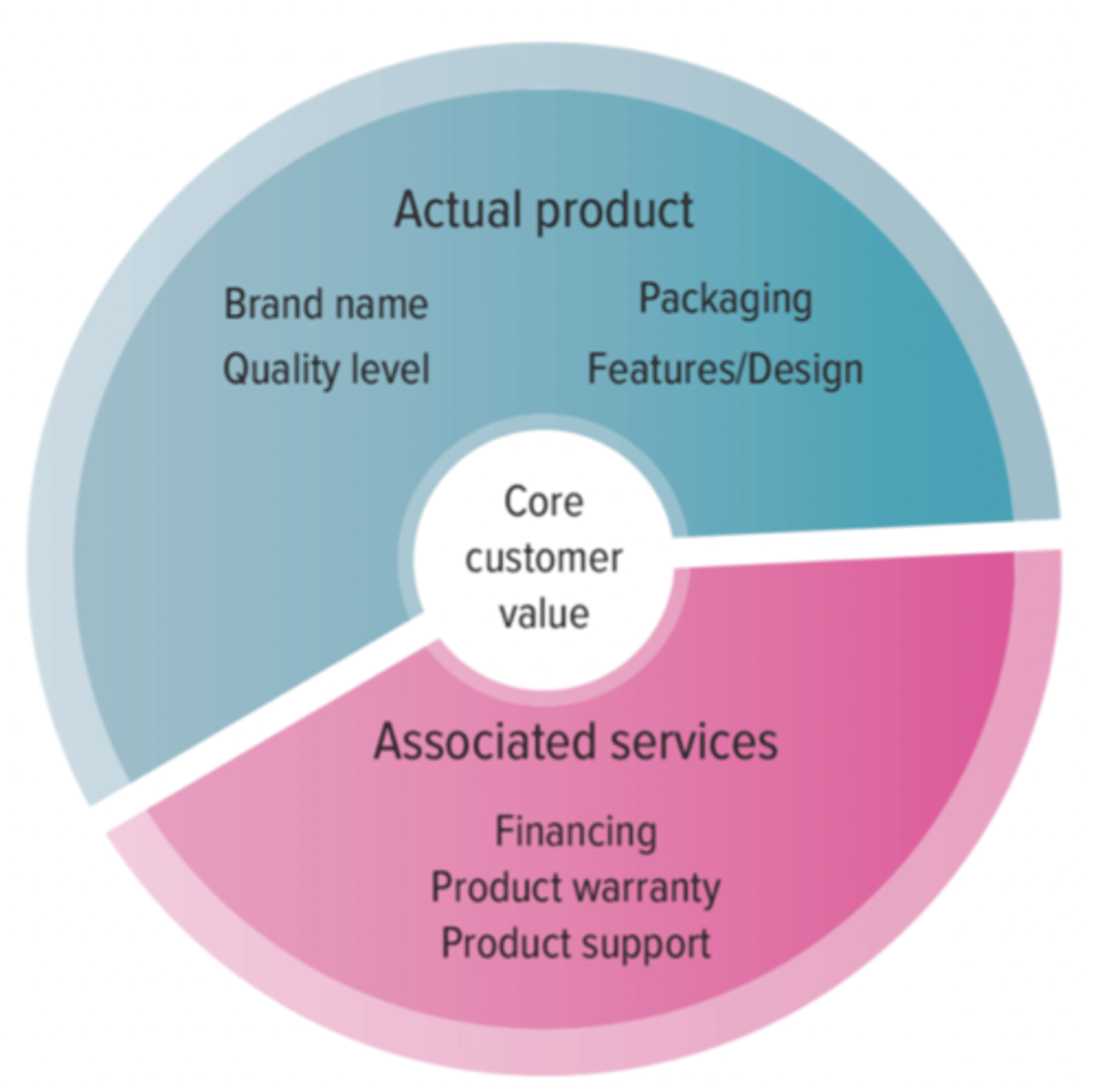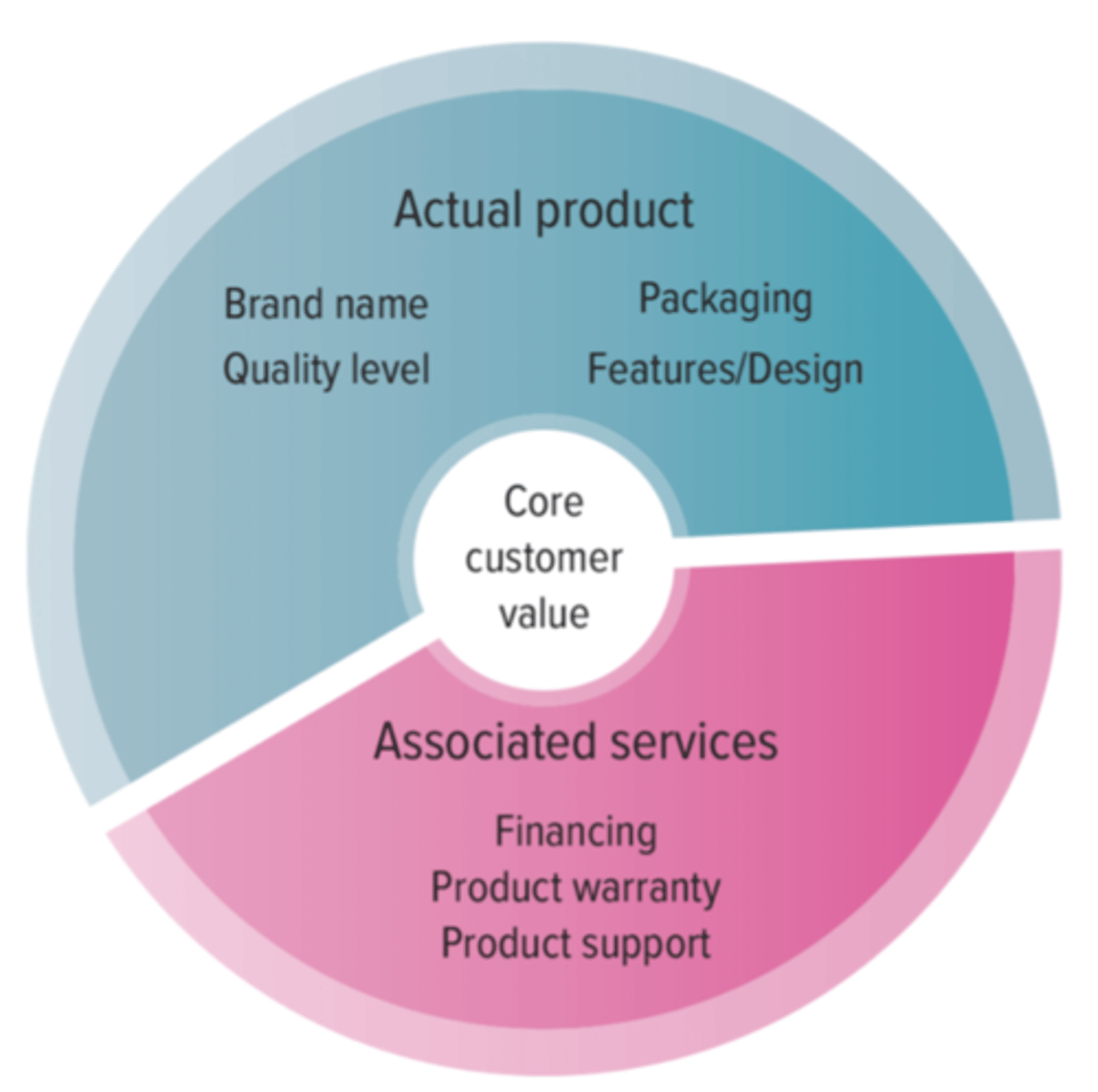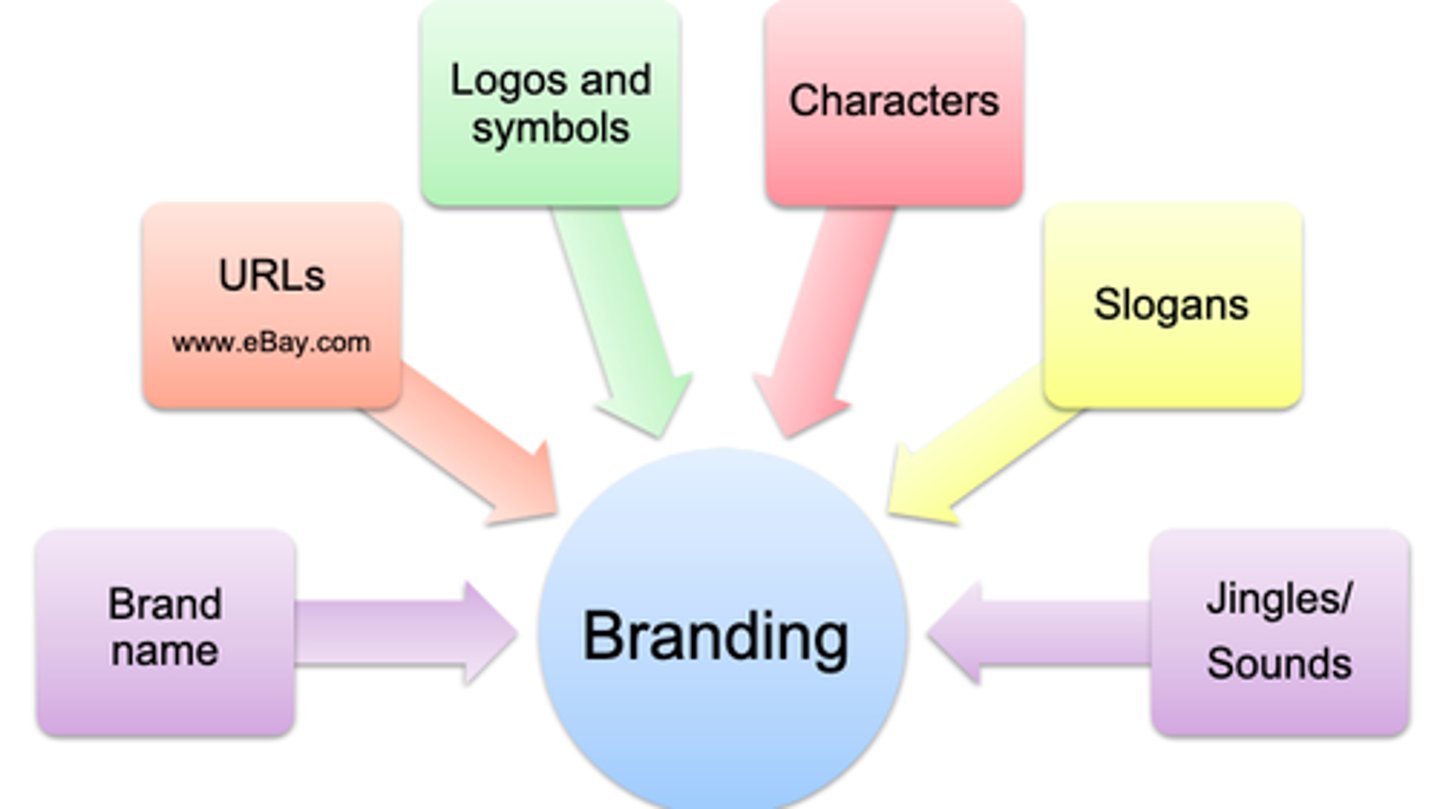Ch 11: Product, Branding, and Packaging Decisions
1/46
There's no tags or description
Looks like no tags are added yet.
Name | Mastery | Learn | Test | Matching | Spaced |
|---|
No study sessions yet.
47 Terms
Complexity of Products: Product complexity diagram
- When developing or changing a product, marketers start with the core customer value to determine what their potential customers are seeking. Then they make the actual physical product and add associated services to round out the offering

Complexity of Products: Define Core Customer Value
The basic problem-solving benefits that consumers are seeking
- what are customers looking for?

Complexity of Products: Define Actual Product
- the physical attributes of a product including the brand name, features/design, quality level, and packaging (level of importance for attributes differs depending on the product)
- Marketers convert core customer value into an actual product

Complexity of Products: Define Associated Services
- AKA Augmented Product
- the nonphysical attributes of the product including product warranties, financing, product support, and after-sale service
- # of associated services varies with the product

Types of Products: Define Consumer Products
- products and services used by people for their personal use
Types Consumer Products: Specialty Products/Services
- those for which customers express such a strong preference that they will expend considerable effort to search for the best suppliers
Types Consumer Products: Shopping Products/Services
- p/s for which consumers will spend a fair amount of time comparing alternatives, such as furniture, apparel, fragrances, appliances, and travel (ex: going to different shoe stores to find the right pair)
Types Consumer Products: Convenience Products/Services
- p/s for which the consumer is not willing to expend any effort to evaluate prior purchase
- frequently purchased commodity items , usually bought with very little thought, such as common beverages, bread, or soap.
Types Consumer Products: Unsought Products/Services
- p/s that consumers either do not normally think of buying or don't know about
- req lots of marketing effort and various forms of promotion
- when new-to-the-world products are first introduced, they are unsought products
Product Mix
- the complete set of all products and services offered by a firm
Product Lines
- the product mix consists of these
- groups of associated items that consumers tend to use together or think of as part of a group of similar products or services
Product Mix Breadth
- The product mix reflects the breadth and depth of the companies product lines
- represents a count of the number of product lines offered by the firm
- too much breadth in the product mix becomes costly to maintain, and too many brands may weaken the firms reputation
- narrow or wide
Product Line Depth
- The product mix reflects the breadth and depth of the companies product lines
- the number of products within a product line
Cannibalize
- If the products are too similar, sales of one brand may cannibalize, or take away sales from the other brand, with no net sales, profit, or market share increase
Why change product line depth?
- Increase Depth: Firms may add items to address changing consumer preferences or to preempt competitors while boosting sales
- Decrease Depth: Delete products within a product line to realign the firm's resources. Never taken lightly. Eliminating unprofitable or low-margin items and refocus their marketing efforts on more profitable items
Why change product mix breadth?
- Decrease Breadth: delete entire product lines to address changing market conditions or meet internal strategic priorities
- Increase Breadth: add new product lines to capture new or evolving markets and increase sales
What makes a brand? (attributes of an actual product)
brand name, URLs, logos and symbols, characters, slogans, jingles/sounds

Top 5 Global Brands
1. Apple
2. Microsoft
3. Amazon
4. Google
5. Samsung
Value of Branding for the Customer: Brands Facilitate Purchases
- brands are easily recognized by consumers and, because brands signify a certain quality level and contain familiar attributes, they help consumers make quick decisions, especially abt their purchases
Value of Branding for the Customer: Brands Establish Loyalty
- over time and with continued use, customers lean to trust brands; strong affinity towards them
Value of Branding for the Customer: Brands Protect from Competition and Price Competition
- Strong brands are somewhat protected from competition from other firms and price competition
- Because such brands are more established in the market and a more loyal customer base, neither competitive pressures on price nor retail-level competition is as threatening to the firm
Value of Branding for the Customer: Brands are Assets
- For firms, brands are also assets that can be legally protected through trademarks and copyrights and thus constitute a unique form of ownership
- firms sometimes have to fight to ensure their brand names are not being used, directly or indirectly, by others (cough cough evermore)
Value of Branding for the Customer: Brands Affect Market Value
- the value of a company is its overall monetary worth, comprising a vast number of assets. When the brand loses value, it also threatens other assets - The earning potential of a brand over a 12-month period is known as its brand value
Brand Equity
- the set of assets and liabilities linked to a brand that adds to or subtracts from the value provided by the product or services
4 Aspects of a Brand Equity
brand awareness, perceived value, brand associations, brand loyalty
4 Aspects of a Brand Equity: Brand Awareness
- measures how many customers in a market are familiar with the brand and what it stands for and have an opinion about it
- the more aware of or familiar with it they are, the easier their decision-making process is, which improves the chances of purchase
- If the consumer recognizes the brand, it probably has attributes that make it valuable ( good for both products bought with little thought and also infrequent items)
- Companies must protect their brand names bc if they are used so generically, over time the brand itself can lose its trademark status
4 Aspects of a Brand Equity: Perceived Value
- the relationship btwn a product's or service's benefits and its cost
- customers usually determine the offering's value in relation to the value of its close competitors
- if they believe a less expensive brand is about the same quality as a premium brand, the perceived value of that cheaper choice is high
4 Aspects of a Brand Equity: Brand Associations
- the mental and emotional links that consumers make btwn a brand and its key product attributes, such as a logo and its color, a slogan, or a famous personality
- often result from a firm's advertising and promotional efforts
4 Aspects of a Brand Equity: Brand Loyalty
- consumer buys the same brad's product or service repeatedly over time rather than buying from multiple suppliers within the same category
- reward programs
- marketing costs of reaching loyal consumers are lower
- positive word of mouth
- don't switch to competitors bc #loyal
5 decisions surrounding the brand related strategies to create and manage key brand assets
- whether to use manufacturer brands or retailer/store brands
- how to name brands and product lines
- whether or not to extend the brand name to other products and markets
- should the brand name be used with another firm or licensed to another firm
- whether or not the brand should be repositioned
Brand Ownership
- brands can be owned by any firm in the supply chain
- 2 brand ownership strats: manufacturer/national brands and retailer/store brands
- also brands can be marketed using common/family name or as individual brands
Brand Ownership: Manufacturer/National Brands
- owned and managed by the manufacturer
- manufacturer develops the merch, produces it to encure consistent quality, and invests in a marketing program to establish an appealing brand image
- majority of brands marketed in U.S> are manuf brands
- by owning their brands, manuf retain more control over their marketing strategy, are able to choose the appropriate market segments and positioning for the brand, and can build the brand and thereby create their own brand equity
Brand Ownership: Retailer/Store Brands
- AKA private-label brands
- products developed by retailers
- In some cases, retailers manufacture their own products; in other cases they develop the design and specifications for their retailer/store brands and then contract with manufactures to produce those products
- Some national brand manufacturers work with retailers to develop a special version of their standard merchandise offering to be sold exclusively by the retailer
- becoming more and more common
Naming Brands and Product Lines: Family Brands
- a firm's own corporate name used to brand its product lines and products
- the individual brand benefits from the overall brand awareness associated with the family name
Naming Brands and Product Lines: Individual Brands
- individual brands names for each of the firm's products
- Kraft-> philly cream cheese, jello, oscar mayer
Brand Extension
- the use of the same brand name in a different prduct line
- an increase in the product mix's breadth
Line Extension
- use of the same brand name within the same product line and represents an increase in a product line's depth
Three Advantages to using the same brand name for new products
1. bc the brand name is already well established, the firm can spend less in developing consumer brand awareness and brand associations for the new product
2. if either the original brand or the brand extension has strong consumer acceptance, that perception will carry over to the other product
3. when the brand extensions are used for complementary products, a synergy exists btwn the two products that can increase overall sales
Brand Dilution
- when the brand extension adversely affects consumer perceptions about the attributes the core brand is believed to hold
4 things firms should consider to prevent the potentially negative consequences of brand extensions
1. marketers should evaluate the fit btwn the product class of the core brand and that of the extension. If the fit is high, consumers will consider the extension credible and the brand association will be stronger for the the extension
2. Firms should evaluate consumer perceptions of the attributes of the core brand and seek out similar attributes for the extension bc brand-specific associations are very important for extensions
3. Firms should refrain from extending the brand name to too many products and product categories
4. Firms should consider whether the brand extension will be distanced from the core brand, especially if the firm wants to use some but not all of the existing brand associations
Co-branding
- marketing two/more brands together on the same package, promotion, or store
- can enhance consumers' perceptions of product quality by signaling unobservable product quality through links btwn the firm's brand and a well-known quality brand
- creates risk when the customers of each of the brands turn out to be vastly different or when there are disputes or conflicts of interest btwn the co-brands
Brand Licensing
- contractual arrangement btwn firms whereby one firm allows another to use its brand name, logo, symbols, and/or characteristics in exchange for a negotiable fee
- common for toys, apparel, accessories, and entertainment
- the firm that provides the right to use its brand (licensor) obtains revenues thru royalty payments from the firm that has obtained the right to use the brand (licensee) These royalty payments may take the form of up-front, lump-sum licensing fees or be based on the dollar value of sales of the licensed merchandise
Brand Repositioning
- aka rebranding
- a strategy in which marketers change a brand's focus to target new markets or realign the brand's core emphasis with changing market preferences
- costs a lot of money
Primary Package
- one the consumer uses (toothpast tube)
- consumers seek convenience in terms of storage, use and consumption
Secondary Package
- wrapper or exterior carton that contains the primary package and provides the UPC label used by retail scanners
- consumers use this to find additional info that may not be available on the primary package
- add value by facilitating the convenience of carrying, using, storing the product
Sustainable Packaging
- less neg impact on environment
- rapidly evolving
Product Labeling
labels on products and packages provide information the consumer needs for his or her purchase decision and consumption of the product
- req by laws and regulations